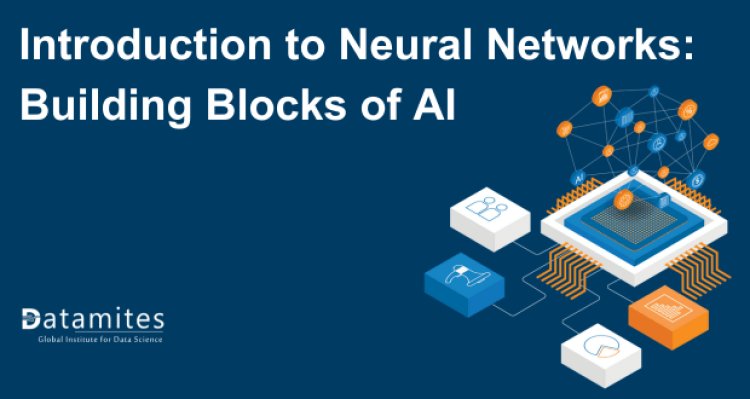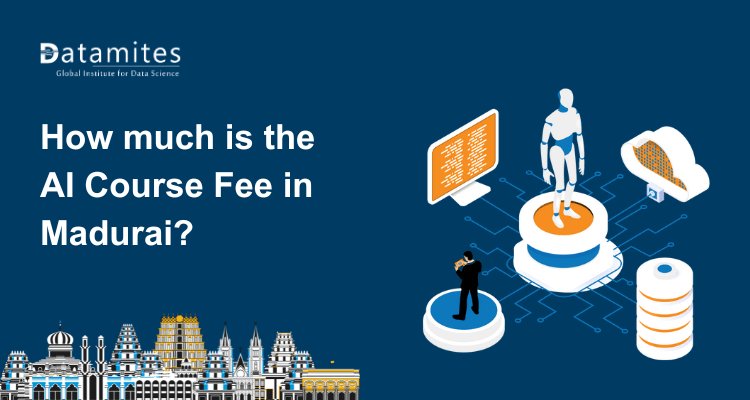Introduction to Neural Networks: Building Blocks of AI
Neural networks are the foundation of modern AI, mimicking the human brain's structure to solve complex problems. This blog explores the building blocks that power machine learning and deep learning models.

Artificial Intelligence (AI) has become an integral part of our everyday lives, reshaping our interactions with technology and altering our experiences in profound ways. From voice-activated assistants like Siri and Alexa to personalized recommendations on Netflix and Spotify, AI's influence is ubiquitous. This pervasive presence underscores the importance of understanding the core technologies that make AI possible.
At the heart of many AI applications lies a remarkable technology: neural networks. These sophisticated models enable machines to analyze data, recognize patterns, and make intelligent decisions. This blog post delves into neural networks, unraveling their structure, function, and significance in the realm of AI.
Brief Explanation of Artificial Intelligence
Artificial Intelligence is a field within computer science dedicated to developing systems that can perform tasks usually associated with human intelligence. These tasks include problem-solving, learning, reasoning, and understanding natural language. AI systems can be divided into two main categories: narrow AI, which is built to perform specific tasks, and general AI, which seeks to emulate the full range of human cognitive abilities.
Read these articles:
- Introduction to Artificial Intelligence - Key Concepts
- Artificial Intelligence vs Machine Learning
- Artificial Intelligence In Media and Entertainment Industries
Definition of Neural Networks in Simple words
Neural networks are a type of machine learning algorithm inspired by the structure and function of the human brain. These systems consist of nodes, or "neurons," organized into layers that are intricately connected, mimicking the brain's network to process information. These networks can learn from large datasets, making them pivotal in developing AI applications.
Importance of Neural Networks in AI and Machine Learning
Neural networks are crucial in AI and machine learning because they mimic the human brain's ability to recognize patterns and make decisions. Here’s why they’re so important:
- Pattern Recognition: Neural networks excel at identifying patterns in data, which is essential for tasks like image and speech recognition. They can enhance their performance by studying examples and refining their skills over time.
- Versatility: They can be applied to a wide range of problems, from natural language processing and computer vision to medical diagnosis and financial forecasting.
- Learning from Data: Neural networks can learn complex relationships and representations in data without requiring explicit programming for each specific task. This is accomplished by training on extensive datasets.
- Scalability: They handle large volumes of data efficiently and can scale to accommodate growing amounts of information, which is critical for modern AI applications.
- Feature Extraction: Deep neural networks, in particular, are adept at automatic feature extraction. They can identify and learn relevant features from raw data, reducing the need for manual feature engineering.
- Advancements in Deep Learning: Neural networks are the backbone of deep learning, a subset of machine learning that has driven many recent advancements in AI, such as self-driving cars and advanced language models.
How Neural Networks Work
Neural networks are a core component of artificial intelligence and machine learning, drawing inspiration from the human brain's architecture and operations. Here's a straightforward breakdown of their functionality:
Neurons: Artificial neurons, which are the basic building blocks of a neural network, are modeled after biological neurons. Each neuron receives inputs, processes them, and passes the result to other neurons.
Layers: Neurons are organized into layers:
- Input Layer: This is where the network gets its first set of information. Each neuron in this layer represents one feature or aspect of the input data.
- Hidden Layers: These intermediary layers, situated between the input and output layers, are responsible for performing calculations and extracting features from the input data. A neural network can have a single hidden layer or multiple ones.
- Output Layer: This layer generates the ultimate output or prediction, with its number of neurons matching the total number of potential outcomes or categories.
Weights and Biases: Every link between neurons carries a weight that defines the strength of the connection. Each neuron also has a bias, which helps adjust the output along with the weighted input. During the training process, the weights and biases are continuously fine-tuned and optimized.
Activation Function: Once a neuron has handled its inputs by computing a weighted sum and incorporating a bias, it then uses an activation function to determine if it should be activated. Popular choices for activation functions are ReLU (Rectified Linear Unit), sigmoid, and tanh.
Forward Propagation: This is how data moves from the starting point to the end point across the network. Each layer processes the data, alters it, and then sends the updated version to the next layer.
Loss Function: After forward propagation, the network's output is compared to the actual target values using a loss function. This function measures how well the network’s predictions match the actual outcomes.
Backpropagation: This is the method used to train the network. It involves adjusting the weights and biases to minimize the loss function. The network calculates the gradient of the loss function with respect to each weight using the chain rule and updates the weights accordingly. This process is repeated iteratively over many epochs.
Training and Learning: The network refines its performance by tweaking its weights and biases through a process called backpropagation, learning from the data it processes. The goal is to minimize the error in the network’s predictions, allowing it to generalize well to new, unseen data.
Neural networks learn to associate inputs with outputs by fine-tuning their weights and biases during training. This process allows them to identify patterns and make predictions based on the data they've been exposed to.
Refer these articles:
- What Is AI Engineer Course
- What is Datamites Certified Data Analyst Certification
- What is Certified Data Scientist Course
Types of Neural Networks
Neural networks come in various types, each suited for different tasks and applications. Here’s a summary of some frequently encountered types:
- Feedforward Neural Networks (FNNs): The most straightforward kind of neural network features a unidirectional flow of information, traveling from the input layer through one or more hidden layers and finally reaching the output layer. They are often used for basic classification and regression tasks.
- Convolutional Neural Networks (CNNs): Designed for processing structured grid data, such as images. CNNs leverage convolutional layers to autonomously and flexibly capture spatial feature hierarchies. They are widely used in image and video recognition, as well as in tasks like object detection and image segmentation.
- Recurrent Neural Networks (RNNs): Ideal for handling sequential data or time series. RNNs feature connections that create directed loops, enabling them to retain and recall information from past inputs. They are used in applications like language modeling, speech recognition, and time series forecasting. A popular variant is the Long Short-Term Memory (LSTM) network, which helps to overcome some of the limitations of standard RNNs.
- Generative Adversarial Networks (GANs): Comprising two networks—a generator and a discriminator—that compete against each other. The generator crafts artificial data, and the discriminator assesses its genuineness. GANs are employed to create lifelike images, artwork, and enhance data through augmentation.
- Autoencoders: Autoencoders, designed for unsupervised learning, transform input data into a compact representation before reconstructing it back to its original form. They are commonly employed for reducing dimensionality, extracting features, and removing noise.
- Transformers: Mainly employed for tasks related to natural language processing (NLP). Transformers rely on self-attention mechanisms to handle dependencies in sequences, making them highly effective for tasks like translation, text generation, and summarization. The architecture has been adapted for other domains as well, such as image processing.
- Graph Neural Networks (GNNs): Designed to work with graph-structured data, where nodes represent entities and edges represent relationships. GNNs are used for tasks involving network data, like social networks, molecular chemistry, and recommendation systems.
Each type of neural network is suited to different types of problems, and the choice of network often depends on the nature of the data and the specific task at hand.
Applications of Neural Networks
Neural networks are highly adaptable and find use in a wide array of domains due to their remarkable versatility. Here are some key areas where they're commonly used:
Image and Speech Recognition:
- Image Recognition: Neural networks, especially convolutional neural networks (CNNs), are used for tasks like facial recognition, object detection, and image classification.
- Speech Recognition: Recurrent neural networks (RNNs) and transformers are applied to transcribe spoken language into text and for voice assistants like Siri and Alexa.
Natural Language Processing (NLP):
- Text Classification: Neural networks are used for sentiment analysis, spam detection, and topic classification.
- Machine Translation: Models like transformers (e.g., BERT, GPT) are used for translating text between languages.
- Text Generation: Generative models have the ability to produce text that is both coherent and contextually appropriate, making them useful for chatbots and content creation.
Healthcare:
- Medical Imaging: Neural networks help in diagnosing diseases from X-rays, MRIs, and CT scans by identifying patterns and anomalies.
- Predictive Analytics: They are used for predicting patient outcomes and disease outbreaks.
Finance:
- Fraud Detection: Neural networks can identify unusual patterns and potential fraud in transactions.
- Algorithmic Trading: They analyze market trends and execute trades based on predictive models.
Autonomous Vehicles:
- Self-Driving Cars: Neural networks process data from sensors and cameras to navigate and make decisions in real-time.
Gaming and Entertainment:
- Game AI: They enhance non-player character behavior and create dynamic game experiences.
- Content Creation: Neural networks have the remarkable ability to create music, craft art, and even produce convincing deepfake videos.
Manufacturing:
- Predictive Maintenance: They predict equipment failures and optimize maintenance schedules.
- Quality Control: Neural networks inspect products for defects during production.
Refer these articles:
- Guide to Artificial Intelligence Career
- Artificial Intelligence Course Fee in India
- Artificial Intelligence Career Scope in India
Role of neural networks in advancing AI research
Neural networks have played a crucial role in advancing AI research across various domains. Here's a concise summary of their influence:
- Deep Learning: They enable deep learning models that can automatically learn representations from data, improving tasks like image and speech recognition.
- Pattern Recognition: Neural networks excel in identifying patterns and correlations in large datasets, leading to breakthroughs in various domains.
- Generative Models: Methods like Generative Adversarial Networks (GANs) and Variational Autoencoders (VAEs) use neural networks to produce highly realistic synthetic data and push the boundaries of creative innovation.
- Transfer Learning: Pre-trained neural networks can be fine-tuned for specific tasks, reducing the need for large datasets and training times.
- Reinforcement Learning: They are integral to reinforcement learning algorithms, enabling systems to learn optimal actions through trial and error.
- Natural Language Processing: Neural networks drive advancements in NLP, enabling more sophisticated language models and chatbots.
Challenges and Considerations of Neural networks
Neural networks have made significant strides in various fields, but they come with their own set of challenges and considerations. Here are some key points:
- Data Requirements: Neural networks often need a substantial amount of data to train efficiently. Inadequate data can lead to overfitting or poor generalization.
- Computational Resources: Training deep neural networks demands substantial computational power, typically necessitating the use of specialized hardware such as GPUs or TPUs. This can be expensive and resource-intensive.
- Overfitting: Neural networks, especially deep ones, can overfit to the training data, meaning they perform well on the training set but poorly on new, unseen data. Methods such as regularization, dropout, and cross-validation are employed to reduce these issues.
- Interpretability: Neural networks are often criticized for being "black boxes." It can be challenging to understand how they make decisions, which is a concern for applications where interpretability is crucial, such as in healthcare or finance.
- Hyperparameter Tuning: Neural networks have many hyperparameters (e.g., learning rate, number of layers, batch size) that need to be carefully tuned. This procedure can be lengthy and demands a high level of skill.
- Bias and Fairness: If the training data has biases, the neural network might pick them up and continue them, which can result in unfair or discriminatory results. Achieving fairness and reducing bias remains a continuous and complex challenge.
- Scalability: While neural networks can scale well with large datasets, scaling to very large networks or datasets can present challenges in terms of computational efficiency and storage.
- Ethical Concerns: The deployment of neural networks, especially in sensitive areas, raises ethical questions about privacy, security, and potential misuse.
- Maintenance and Updating: Neural networks can become outdated as new data or scenarios emerge. To keep things up-to-date and correct, you need to regularly update and maintain them.
Addressing these challenges involves a combination of technical solutions, ethical considerations, and ongoing research and development.
As we've explored in this introduction to neural networks, understanding the intricacies of these AI building blocks is crucial for anyone looking to excel in the rapidly evolving field of artificial intelligence. For those ready to deepen their expertise, the DataMites Institute offers comprehensive courses designed to equip professionals with the skills needed to thrive in today's data-driven industry.
DataMites is a leading provider of data science and Artificial Intelligence training, renowned for its industry-oriented curriculum and extensive range of courses. Our courses are meticulously crafted to meet the demands of the industry, offering a blend of theoretical knowledge and practical application. Our partnerships with esteemed organizations like the International Association of Business Analytics Certification (IABAC) and NASSCOM FutureSkills ensure that our curriculum remains at the forefront of technological advancements.
The Artificial Intelligence course at DataMites delves into key concepts, tools, and techniques that empower learners to build and deploy sophisticated AI models. Students gain hands-on experience through projects and case studies, ensuring they are well-prepared to tackle real-world challenges.
Beyond coursework, DataMites supports learners with a suite of resources including workshops, internship, and personalized job placement assistance. These resources are designed to enhance professional growth and facilitate a successful transition into AI roles.
Whether you're a beginner or an experienced professional looking to upskill, DataMites is committed to guiding you on your journey to mastering artificial intelligence. Explore our programs today and take the next step towards a rewarding career in AI.
DataMites Training Institute offers a thorough Artificial Intelligence course, accredited by global certifications for industry recognition. The program includes machine learning, deep learning, and AI tools, featuring practical projects and expert mentorship. With flexible learning options such as online and classroom formats, it caters to both beginners and professionals. DataMites' globally recognized certification equips learners with the skills needed for AI-driven career opportunities.





